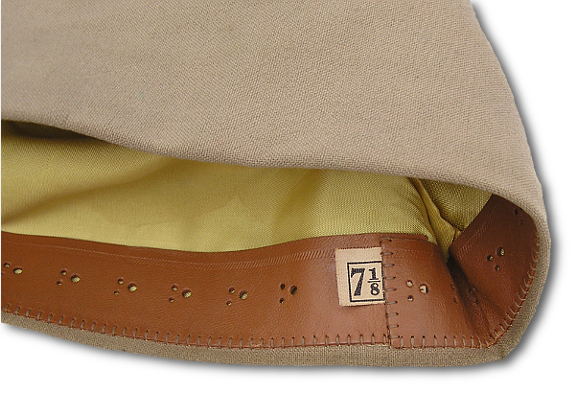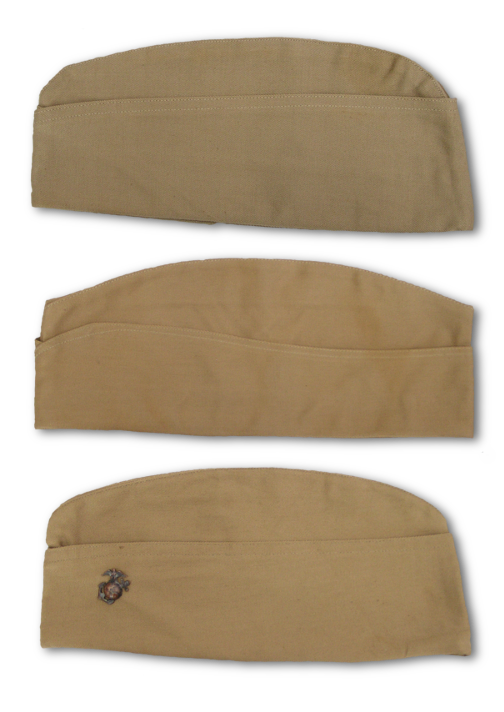U.S. Navy Men's Caps
Garrison Cap

Above, left: Naval aviator's garrison cap with miniature wings pinned to the left side and rank insignia on the right. Above, middle: Chief Petty Officer's garrison cap with miniature cap device pinned to the left side. Above, right: Officer's garrison cap with miniature cap device pinned to left side and rank insignia on the right.
Cap Colors & Materials

Above, left to right: Khaki cap made in cotton twill, khaki cap made in summer weight worsted wool, gray cap made in cotton twill, forestry green cap made in wool elastique, and blue cap made in wool suiting. During WWII Navy garrison caps were produced in all of the standard uniform colors including white (not pictured). There were also many variations in fabrics. For example, garrison caps for the working khaki and gray uniforms were made in both cotton and wool.
In March, 1943, garrison caps were approved as an optional wear item in lieu of the peaked service cap. Garrison caps were approved for wear with officer's, warrant officer's, chief petty officer's, steward's, and cooks' service and working uniforms. Prior to this order garrison caps were authorized for the summer and winter working uniforms worn by officers, warrant officers, and chief petty officers who were designated as naval aviation pilots. Garrison caps were purchased by those authorized to wear them. Wear of the Garrison cap was permitted unless the combination cap was prescribed by the commanding officer.
(touch or point mouse at picture for expanded view)
|
Prior to the outbreak of WWII, garrison caps were authorized as optional equipment for officers, warrant officers, and chief petty officers designated as naval aviation pilots. Navy pilots wore garrison caps with their green and khaki working uniforms and attached miniature aviation insignia to the left front. Then, in February 1943 authorization for the use of the garrison cap was expanded to include all Navy personnel who wore the peaked cap. Additionally, at this time the garrison cap was approved for wear with the standard blue and white service uniforms and all shades of the working uniform. When use of the garrison cap was expanded it remained an optional piece of equipment for both officers and enlisted men. Adoption of the garrison cap during wartime was purposeful in that it helped conserve materials, freed stowage space, and made outfitting for new personnel less expensive. The small, foldable, easily cared for cap was a significant convenience to thousands of Navy personnel shipped overseas to busy combat zones during the war; and especially so when compared to the care requirements of the much more fragile peaked cap. Navy regulations called for a soft foldable cap that was to be made of the same material, color, and texture as the uniform being worn. Caps could be made from a variety of materials including cotton twill, lightweight tropical wool, broadcloth, kersey, elastique, serge, or whipcord. There was no difference between officer's and enlisted men's caps in appearance and construction materials. Cotton caps were unlined and constructed of the same material throughout, including the sweatband. Wool caps were lined, usually with rayon, and had a leather sweatband stitched to the inside. The cut of the Navy cap gave it a distinctive appearance when compared to garrison caps worn by the Army and Marine Corps. When made to correct specifications, the cap was to be rounded and without points at both ends, and the back was to be taller than in front by one (1) inch. Overall, the cap was to be three (3) inches in height at the front and four (4) inches in height in the rear. Additionally, the apron upturn was to be 3-1/4 inches at the front slanting to 2-1/2 inches in the rear creating a distinctive rolling wave pattern, which gave the cap its distinctive appearance.
Commissioned officers wore their rank insignia on the right front of the cap and a miniature cap insignia on the left front. The miniature cap insignia was the same Navy shield design worn on the commissioned officer's peaked cap except that it was to be 1-1/4 inches in height. Warrant officers wore gold corps devices on both sides of their garrison caps near the front. Chief warrant officers wore silver corps devices on the right side of their caps and a miniature cap device on the left side. |
Chief petty officers wore a miniature version of the CPO cap device on the left side of their garrison caps. The miniature device was to be 1-1/2 inches in height consisting of the same gold fouled anchor and silver "U.S.N." design used on the peaked cap. Cooks and stewards wore a device consisting of the letters "U.S.N." in gold on the left side of their garrison caps. The same size device was used on both the peaked and garrison caps. Commissioned officers, warrant officers, and chief petty officers qualifying as aviation pilots wore miniature aviation insignia ("wings") on the left side of their garrison caps. Commissioned officers and warrant officers also wore their rank insignia on the right side of the cap. Garrison caps were manufactured by numerous companies and purchased at post exchanges, uniform shops, and various tailors by those authorized to wear them. Being a private purchase item, garrison caps did not have contract labels in them and most did not have manufacturer labels either. Some better made examples, however, did have manufacturer labels applied to them. Some wool caps had labels either embossed or printed on the leather sweatband. Most caps had a size tariff either ink stamped on the inside or attached to the sweatband by a small cloth label. Without contract labels and with the existence of numerous manufacturing variances, exact dating of Navy garrison caps is difficult without knowing the original history of an example. Navy specifications called for the top of the garrison cap to be formed using an expansion seam extending the length of the cap. This seam was to create a spread of 1-1/2 inches at the top, center of the cap when it was being worn. During the WWII era it was a common practice to have the expansion seam re-sewn from the inside to reduce the spread at the top. Doing so caused the cap to sit higher on the head giving it a neater and tidier appearance. In 1947 new uniform regulations were introduced that again restricted use of the garrison cap to wear with the working uniforms as was the case in pre-war times. Effective June 1, 1947, the blue and white garrison caps were dicontinued. A variety of quality and workmanship can be found when examining WWII era Navy garrison caps. Some manufacturers adhered to published Navy specifications with outstanding exactness, while others fell noticeably short of what the regulations called for. Those being sold along with uniforms bearing the "Regulation US Navy Uniform" label tended to conform to specifications better than some made by other suppliers. |









